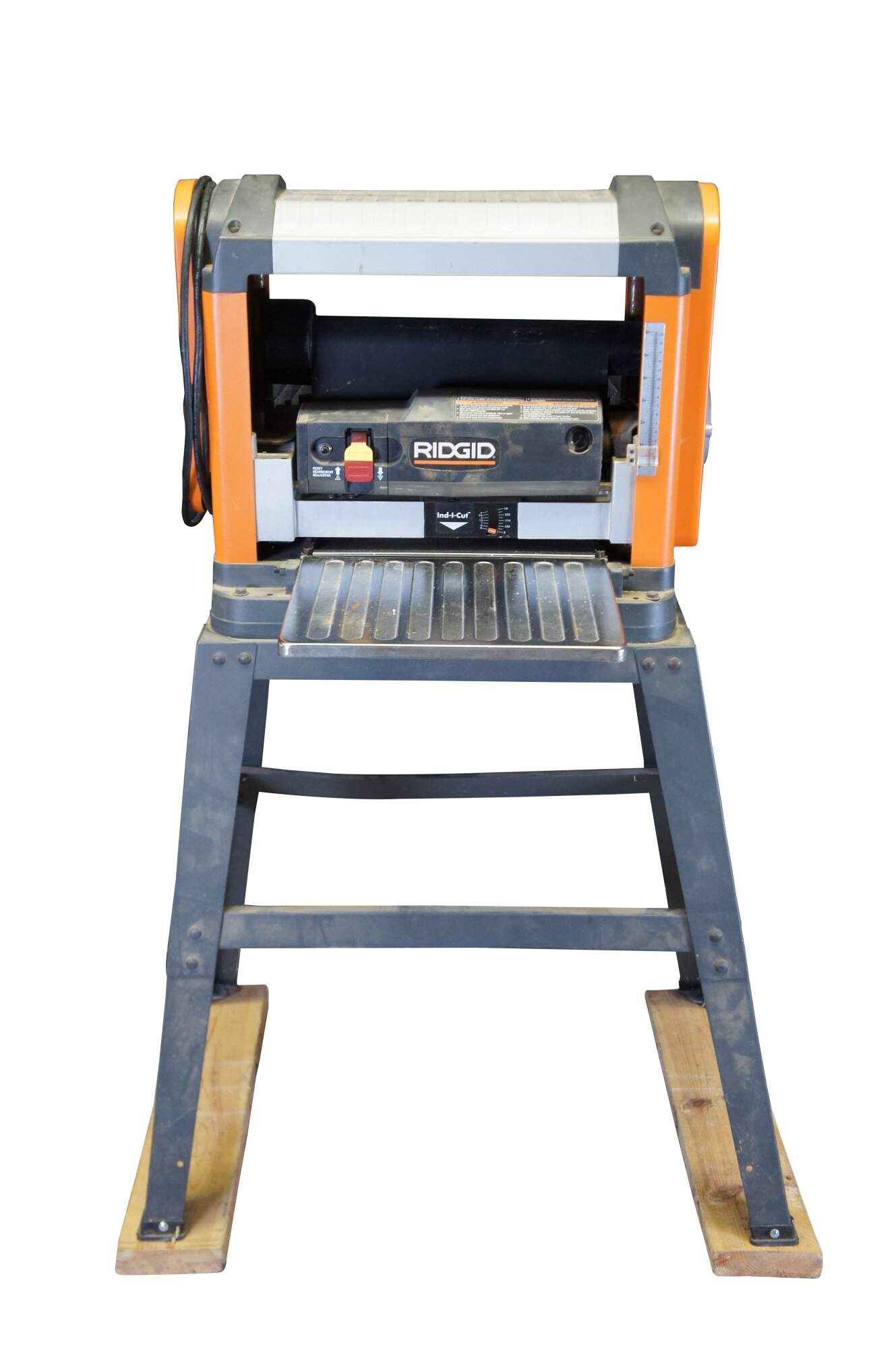
Shipping:
Free Shipping Included
Delivery:
Estimated 2-15 Business Days
Payments:
Credit Card, Check, Cash, PayPal, Apple Pay, Venmo
Returns:
30 Days 100% Money Back Guarantee, Buyer Pays Return Shipping
Description
Description
The Ridgid TP1302 wood Planer can plane stock up to 13 inches wide and 6 inches thick. It has a powerful 15amp motor (with overload protection) with a maximum depth of cut of 1/8". The planer has a very substantial feel to it and sits atop an included stand but can also be used without the stand. It's two knife cutter head delivers 66 cuts per inch and moves material through at a rapid 26 feet per minute.
Portability
Once upon a time portable planers (aka "lunch-box" planers) were light and simple 10 to 12 inch units that one could fairly easily lug to a job site. These were basic no-frills machines intended primarily for carpenters. However, it didn't take long for woodworkers to latch onto these units as alternatives to heavy and expensive stationary planers. Nowadays, these planers have evolved into heavier machines with more advanced features and wider capacities. At 85 pounds, the Ridgid is no feather weight and like other machines of this class it is not something one would want to portage up a flight of stairs at a job site too often. Carrying handles are formed into the side of the machine to make toting easier if needed. Apparently recognizing that a great many of these machine are used as stationary tools, Ridgid has provided a fairly sturdy stand for the planer to sit upon.
Assembly
The planer itself is basically fully assembled right out of the box. Assembly is comprised mainly of attaching the dust hood, assembling the included stand, and checking over the machine, this took me less than an hour.
n Use
The Quick Change knives are double edged and there are a set of replacements provided as well. This gives the owner four new cutting edges right out of the box. Since the knives are indexed, re-sharpening is generally not considered an option. The replacement knives have a storage location below one of the tables. Other tools required to maintain the machine are convieniently located behind a side panel on the left of the machine.
The thickness is controlled via a crank wheel on the side of the machine which was very easy to operate, I prefer this style over the crank-on-top style. When the thickness is adjusted on the TP1300 the head moves keeping the planer tables stationary. This is beneficial if extended outfeed tables are used with the machine; the planer tables themselves are chrome plated (which is nice) and are 14" x 34" when folded flat. The cutter head is lockable via a lever located on the right side. This keeps the cutter head from moving under load and causing a big snipe on the work piece ("snipe" is the term used to describe the reduced thickness areas usually found on the infeed and outfeed ends of a board that has been run through a planer. This was a common problem on early planers).
Stock levering can also cause snipe, in my use, I found snipe to be about 0" to 0.02" in general usage with the Carriage Lock engaged. Technique can play a big part in planer operations. One technique to use is to lift up a little on the ends of the boards as they are fed into and retrieved out of the machine. Another technique is to keep the boards as short as possible. For example, there is no need to feed an 8 foot board into the machine when it is going to be cut into shorter lengths anyway. These techniques in themselves eliminate or reduce snipe.
The chip exhaust port on the machine is a fairly narrow slot. It looks like this could clog easily but in my use this never happened. Perhaps one reason for this is that the motor cooling fan is also exhausted in line with the chips helping propel them out of the machine as quickly as possible. The dust hood is attached via three thumb-screws and has both 2.5" and 4" ports. When hooked up to a dust collector, I found the collection to be remarkably good. I recommend using a dust collector with any planer.
The top of the machine is actually a removable hood. It serves as a handy return stand when the planer is operated in a two-person put & take operation. The hood would be removed when changing out the knives.
Machines powered by universal type motors are expected to be loud and although one would never be able to convict the TP1300 of being "quiet", it didn't seem to be much (if any) louder than my induction motored JPM13 (which I found odd).
One of the advanced features of the planer is a depth stop located on the right hand side. This operates basically the same way the depth stop does on a router, only easier. Once the operator sets the desired thickness, the cutter cannot be lowered more than this setting. For many users this would allow for a fairly repeatable method of dimensioning stock to commonly desired thicknesses (1/8" to 1 3/4" in 8 increments)
Summary
The Ridgid TP1302 planer is a very capable machine, in several areas it even clearly out-performs my JPM13. At one time "lunch-box" planers were considered by many to be too light duty for use in a woodworking shop. They have evolved to fill the requirements however and I would have no problem recommending one to be used as a stationary machine.
Condition
Good used working condition, some dirt / dust, bend to stand.
Dimensions
50" x 34" x 24"